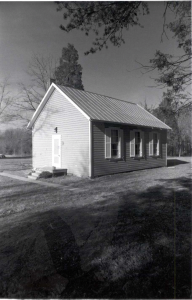The Effects of Brown vs. The Board of Education in Montgomery County
The 1872 Law

Boyds School, 1940s. The Boyds schoolhouse is one of the few pre-consolidation black schools still standing in the county.
An 1872 Maryland law provided that one free (public) school for black students, aged six to twenty, should be constructed in each election district, with the same curricula as white schools. State money was set aside for these schools, and the counties were supposed to help make up the difference. However, Montgomery County’s school board did not use its own money for these “colored schools,” instead relying solely on state funds and the taxes from black communities.
This led to frequent shortages and abrupt terminations of the school year, often as early as March, while the white schools continued on for the full nine-month term. It was left to the communities themselves to prove a need for a school, scout out a potential site, and present themselves to the board. Out of their meager salaries – which were far lower than those of white teachers – teachers at the colored schools had to pay for their transportation and/or room and board. Teachers and parents gave much of their own time and money, to provide as quality an education as was possible under these restrictive circumstances.
